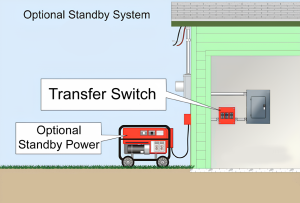How does the 2023 NEC update interconnection and transfer equipment requirements?
Overview
Interconnection and transfer equipment are vital components for the reliability of power systems, especially, during severe faults and challenging conditions. Prior editions of the NEC offered comprehensive instructions for transfer equipment in Section 702.5 but did not do the same for interconnection devices. The 2023 NEC has updated Section 702.5 to include guidelines that encompass both interconnection devices and transfer equipment, enhancing the clarity of the code.This revision aims to improve clarity and promote the correct usage of these components in power system installations.
for interconnection devices. The 2023 NEC has updated Section 702.5 to include guidelines that encompass both interconnection devices and transfer equipment, enhancing the clarity of the code.This revision aims to improve clarity and promote the correct usage of these components in power system installations.
Applying the 2023 Code
Recent technological advancements have led to increased power consumption, requiring enhanced measures for maintaining power system reliability. Two key measures in this regard are the development of interconnection and transfer equipment. Interconnection equipment facilitates the connection of various electrical power sources within a system, including utility mains, standby generators, renewable energy systems, and storage batteries. This equipment promotes the seamless integration of these diverse sources, enabling efficient power distribution and utilization. In contrast, transfer equipment is specifically designed to switch power supply between different sources, particularly during power outages or maintenance events. Its primary function is to transfer the load from the primary power source, such as utility mains, to an alternate power source like a standby generator, facilitating a smooth and safe transition.
In previous editions of the NEC, Section 702.5 outlined the installation, design, measurement, documentation, and operation requirements for transfer equipment, such as transfer switches, for all standby systems. However, similar guidelines were lacking for interconnection equipment, leading to ambiguity and improper practices. The revised Section in the 2023 edition of the NEC includes the necessary guidelines for interconnection devices and provids clarity regarding their use.
What’s New for the 2023 NEC?
The table below presents a comparison between the 2020 NEC and the 2023 NEC regarding Section 702.5.
2020 NEC |
2023 NEC |
| 702.5 Transfer Equipment
(A) General Transfer equipment shall be required for all standby systems subject to the requirements of this article and for which an electric utility supply is either the normal or standby source. Transfer switches shall not be permitted to be reconditioned. Exception: Temporary connection of a portable generator without transfer equipment shall be permitted where conditions of maintenance and supervision ensure that only qualified persons service the installation and where the normal supply is physically isolated by a lockable disconnecting means or by disconnection of the normal supply conductors. (B) Meter-Mounted Transfer Switches Transfer switches installed between the utility meter and the meter enclosure shall be listed meter-mounted transfer switches and shall be approved. Meter-mounted transfer switches shall be of the manual type unless rated as determined by 702.4(B)(2). Informational Note: For more information, see UL 1008M, Transfer Switch Equipment, Meter Mounted. (C) Documentation In other than dwelling units, the short-circuit current rating of the transfer equipment, based on the specific overcurrent protective device type and settings protecting the transfer equipment, shall be field marked on the exterior of the transfer equipment. (D) Inadvertent Interconnection Transfer equipment shall be suitable for the intended use and shall be listed, designed, and installed so as to prevent the inadvertent interconnection of all sources of supply in any operation of the transfer equipment. (E) Parallel Installation Transfer equipment and electric power production systems installed to permit operation in parallel with the normal source shall also meet the requirements of Article 705. |
702.5 Interconnection or Transfer Equipment
(A) General Interconnection or transfer equipment shall be required for all standby systems subject to the requirements of this article. Equipment shall be suitable for the intended use and shall be listed, designed, and installed so as to prevent the inadvertent interconnection of all sources of supply in any operation of the equipment. Exception: Temporary connection of a portable generator without transfer equipment shall be permitted where conditions of maintenance and supervision ensure that only qualified persons service the installation and where the normal supply is physically isolated by a lockable disconnecting means or by disconnection of the normal supply conductors. (B) Meter-Mounted Transfer Switches Transfer switches installed between the utility meter and the meter enclosure shall be listed meter-mounted transfer switches and shall be approved. Informational Note No. 1: See UL 1008M, Transfer Stritch Equipment, Meter Mounted, for more information. Informational Note No. 2: Manual and nonautomatic transfer equipment use human intervention. (C) Documentation In other than dwelling units, the short-circuit current rating of the transfer equipment, based on the specific overcurrent protective device type and settings protecting the transfer equipment, shall be field marked on the exterior of the transfer equipment. (D) Parallel Installation Systems installed to permit operation in parallel with the normal source shall also meet Part I or Part II of Article 705.
|
